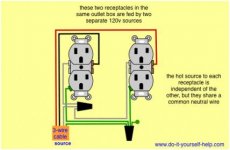A friend of mine has bought a diner and the city want her to replace the outlets in the kitchen with ones that incorporate a GFCI. The inspector said something along the lines of if the ground is wired correctly then she would only need to fit them to the first one.
I'm more familiar with the UK system of ring mains, RCDs, etc but, AAUI, the US uses radial circuits. I've checked the outlets and verified that they are correctly grounded. My proposed next step is to use a device that I have that injects an RF signal into a circuit, by plugging into an outlet. It turns the wires into an antenna and you then move a basic signal tracer over the wall to map the position of the wires.
I hope that, in this way, I'll be able to identify how many radial circuits there are and which outlets are on which. Presumably the "first one" would be the one closest to the breakers?
Does this sound right to y'all? Am I missing anything?
I'm more familiar with the UK system of ring mains, RCDs, etc but, AAUI, the US uses radial circuits. I've checked the outlets and verified that they are correctly grounded. My proposed next step is to use a device that I have that injects an RF signal into a circuit, by plugging into an outlet. It turns the wires into an antenna and you then move a basic signal tracer over the wall to map the position of the wires.
I hope that, in this way, I'll be able to identify how many radial circuits there are and which outlets are on which. Presumably the "first one" would be the one closest to the breakers?
Does this sound right to y'all? Am I missing anything?



